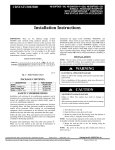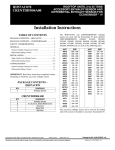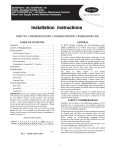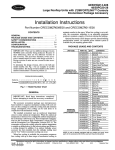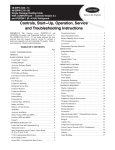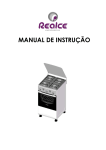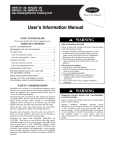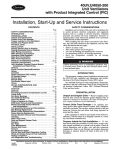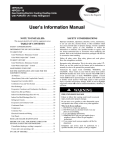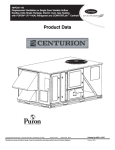Download Carrier 48/50PD05 Specifications
Transcript
CRCBDIOX001B00 48/50PD05–06, 48/50HG014–028, 48/50PG03---28, 48/50PM16---28 CO2 Sensor Accessory Single Package Rooftop Units with COMFORTLink™ Controls Installation, Start--Up and Service Instructions TABLE OF CONTENTS SAFETY CONSIDERATIONS PACKAGE CONTENTS . . . . . . . . . . . . . . . . . . . . . . . . . . . . . . 1 Installation and servicing of air--conditioning equipment can be hazardous due to system pressure and electrical components. Only trained and qualified service personnel should install, repair, or service air--conditioning equipment. When working on equipment, observe precautions in the literature, tags and labels attached to the unit, and other safety precautions that may apply. Follow all safety codes. Wear safety glasses and work gloves. SAFETY CONSIDERATIONS . . . . . . . . . . . . . . . . . . . . . . . . . 1 GENERAL . . . . . . . . . . . . . . . . . . . . . . . . . . . . . . . . . . . . . . . . . 1 INSTALLATION . . . . . . . . . . . . . . . . . . . . . . . . . . . . . . . . . . . . 3 START--UP . . . . . . . . . . . . . . . . . . . . . . . . . . . . . . . . . . . . . . . . . 5 SERVICE . . . . . . . . . . . . . . . . . . . . . . . . . . . . . . . . . . . . . . . . . . 5 TROUBLESHOOTING . . . . . . . . . . . . . . . . . . . . . . . . . . . . . . . 5 IMPORTANT: Read and become familiar with all instructions before beginning installation of CO2 sensor accessory. IMPORTANT: There are two different design revision 48/50HG units currently being produced. Because of these differences, there are two different versions of this accessory. This accessory literature covers accessories manufactured for units with design revision 1. Design revision 0 units are not covered in this accessory book. To determine the design revision, refer to the full unit model number. See Fig. 1 for an example of an HG model number. The design revision number in the model number nomenclature is located in position 13. ! DESIGN REVISION NUMBER Position No. 1 2 3 4 5 6 7 8 9 10 11 12 13 14 15 16 Example: 4 8 H G D 0 1 6 A A A C . Recognize safety information. This is the safety--alert symbol When you see this symbol on the unit and in instructions or manuals, be alert to the potential for personal injury. Understand the signal words DANGER, WARNING, and CAUTION. These words are used with the safety--alert symbol. DANGER identifies the most serious hazards which will result in severe personal injury or death. WARNING signifies a hazard which could result in personal injury or death. CAUTION is used to identify unsafe practices which may result in minor personal injury or product and property damage. NOTE is used to highlight suggestions which will result in enhanced installation, reliability, or operation. 6 1 1 A C07172 Fig. 1 -- Model Number Chart PACKAGE CONTENTS PART NUMBER DESCRIPTION QUANTITY HH99ZZ009 CO2 Sensor 1 HH99ZZ015 Enclosure 1 AL56AU166 Screw --- No. 8 x 1/2 ---in. 4 50TG403323 Unit Wiring Harness (48/50HG014 ---028, 48/50PG20 ---28, 48/50PM16 ---28) 1 48HG400595 Unit Wiring Harness (48/50PG03 ---16, 48/50PD05 ---06) 1 50TG403368 Sensor Wiring Harness 1 HY93NH069 Snap Bushing 2 HY76TB110 Wire Tie 2 Copyright 2009 Carrier Corp. D 7310 W. Morris St. D Indianapolis, IN 46231 ELECTRICAL HAZARD WARNING SHOCK, FIRE AND EXPLOSION Failure to follow this warning could result in personal injury, death or property damage. Before performing service or maintenance operation on unit, turn off main power switch to unit. Shut off gas supply before shutting off main power. Tag gas shut off and power disconnect switch with a suitable warning label. GENERAL The CO2 Sensor (Fig. 2) is designed to monitor carbon dioxide (CO2) levels in the return air and interface with the ComfortLinkt controller on the rooftop air-conditioning unit. The sensor perceives CO2 levels in the 0 to 2,000 parts per million (ppm) range and provides outputs indicating this level. Printed in U.S.A. Edition Date: 11/09 Manufacturer reserves the right to change, at any time, specifications and designs without notice and without obligations. Catalog No:IIK---CRCBDI01---02 Replaces: IIK--- CRCBDI01--- 01 This is one of several approved methods of controlling the indoor-air quality (IAQ) in a building and meets the requirements of local building codes and ASHRAE (American Society of Heating, Refrigerating and Air Conditioning Engineers) Standard 62-1999. The control sensor features a membrane-covered waveguide and sample chamber that produces stable, reliable, and highly accurate carbon dioxide readings. The standard RS-232 port is used to interface directly with a personal computer for easy customization and calibration. A software program is required for calibration of the sensor. The UIP (User Interface Program) and RS-232 serial cable are required (P/N CGCDXPRM001A00). Check Package Contents SIDE VIEW FRONT VIEW MOUNTING PLATE C09547 CRCBDIOX Fig. 2 -- CO2 Sensor The unit utilizes a 4 to 20-mA analog signal. The ComfortLinkt controller uses this signal to control the economizer damper position and ensure an adequate level of outside air in the building. Remove accessory packaging and inspect shipment for damage. If any damage is found, file a claim with the shipping agent immediately. If any item is missing or any part does not assemble properly, notify your Carrier distributor. The Package Contents table on page 1 lists the accessory package contents. Table 1 lists the controller specifications. Fig. 3 shows the CO2 sensor enclosure dimensions. Table 1 – CO2 Specifications ACCURACY At Constant Temperature (78_F) 20 ppm (also repeatability) ± 2.5% of reading or ± 50 ppm whichever is greater ± 5.0% of reading or ± 100 ppm whichever is greater ± 0.05% of reading 0.19% per mm hg <20 ppm with TEMA Self Calibration Feature ± 100 ppm < 1 min. < 6 min. Typical Conditions (60_ to 90_F) (16_ to 32_C) Extended Conditions (32_ to 145_F) (0° to 63_C) Percent Change in Reading per °F Pressure Dependence Annual Drift Maximum Drift (per year) Response Time (at 500 ml/min.) Warm-up Time at 72_F (at 22_C) GENERAL PERFORMANCE Operating Principle Gas Sampling Mode EMI Interface Certification Shock Resistance Sensor Life Data Interface Alarm Threshold Adjust Range Alarm Threshold Adjust Resolution Alarm Threshold Hysteresis Calibration Adjustments Calibration Procedure Recommended Calibration Interval Operating Temperature Range Storage Temperature Range Operating Humidity Range Operating Pressure Range Dimensions (L x W x D) Weight Power Input Isolation Transformer OUTPUT Optional Display Non-dispersive infrared (NDIR) Diffusion FCC Part 15 Class B By the California Energy Commission 40 Gs 15 years Via RS-232 serial port 50 to 50,000 ppm, programmable ± 20 ppm 50 ppm Zero and span via RS-232 serial port Automated with UIP One Year 32_ to 113_F (0° to 45_C) –40_ to 158_ F (–40_ to 70_C) 0 to 95% RH (non-condensing) ± 1.5% local mean pressure 6.4 x 2.2 x 1.7 in. (16.3 x 5.6 x 4.3 cm) 16 oz (454 gm) Nominal 24 vac (50/60 Hz) Not required with half-wave rectification 4-digit green LED display 0 to 10 v or 4 to 20 mA (jumper selected on circuit board) Can be set to any output within maximum range using PC-based UIP Fully adjustable using PC-based program and RS-232 interface. Max: 0 to 2,000 ppm Gold bifurcated, 2 A rating, close on CO2 rise 100 mW max (measured at 6 v DC, 0.1 A) Set point and deadband via PC-based UIP 300 mA average, 500 mA peak 16 to 20 gauge stranded wire Analog Output Maximum Range Analog Output Customization Measurement Range Relay Relay Contact Resistance User Relay Adjustments Current Requirements Wiring Requirements LEGEND TEMA --UIP --- Time Extended Measurement Algorithm User Interface Program 2 1 1/8” 2 1/16” 1” TYP 13/16” 1 3/16” 1 3/16” TOP 1 3/16” 5/16” 4 5/16” 13/16” 2.00” 1 3/16” 1 3/16” 2 13/16” 11/16” 1 3/16” 1” TYP 1 7/8” 7 1/8” 3 9/16” 4 11/16” 3 9/16” 1 3/16” 5 7/16” 5 9/16” 7 1/8” TUBE ROTATED 90° FOR CLARITY 1 1/2” 1 3/16” 1/4” DIA 4 HOLES SIDE C09548 Fig. 3 -- CO2 Sensor Enclosure Dimensions 8. Remove plastic plug from economizer partition. Mount enclosure box to the partition using 4 sheet metal screws, verifying that the 3 cutouts on the inlet tube are facing downward as shown in Fig. 6. 9. Caulk the snap bushing to make sure that the box is completely sealed. 10. Attach sensor to the mounting plate. 11. Route unit wiring harness (P/N 48HG400595) through patch plate on economizer. (See Fig. 4.) Continue running harness with economizer harness, using metal clips and wire ties along top of filter plate. Be sure to leave enough slack so economizer can be tilted out. 12. Remove grommet from compressor partition and route harness through the slot. Replace grommet. 13. Open compressor access panel and locate end of harness. Wire the electrical harness (P/N 48HG400595) to the terminal strips as shown in Fig. 5. 14. Because the return air sensor is at a static zero or negative pressure, relative to ambient air, it is vital that the box be completely sealed. This includes areas where the control wiring enters the box and the perforated tubing enters the box. Once the enclosure is mounted, the return air will enter the inlet holes of the perforated tube, circulate through the sensor chamber and exhaust through the exit slots on the other side of the tube. 15. Connect the ends of the plug (PL18) together. Secure wires so they do not interfere with normal operation. 16. Close and secure the economizer panel and replace the Plexiglas cover. 17. Restore power to unit. PL18 PATCH PLATE IN ECONOMIZER ASY ROUTE HARNESS PL18 THRU CO2 SENSOR ASSEMBLY C09549 Fig. 4 -- CO2 Sensor Location in 48/50PD05--06 and 48/50PG03--16 Units INSTALLATION 48/50PD05--06 and 48/50PG03--16 The CO2 sensor is to be installed in the pre--drilled holes located in the economizer block as shown in Fig. 4. 1. Shut off unit power supply. 2. Open the hinged economizer door and secure. 3. Prepare the sensor enclosure (P/N HH99ZZ015) for mounting by removing the 4 screws on the Plexiglas cover. 4. Remove the CO2 sensor (P/N HH99ZZ009) from the mounting plate. 5. Attach mounting plate to standoffs in the enclosure using the 4 machine screws. 6. Hold the enclosure vertically with the terminal blocks at the bottom and install a snap bushing in the conduit hole located on the right-hand side of the enclosure at the top. 7. Wire the sensor wiring harness (P/N 50TG403368) to the sensor as shown in Fig. 5. Be sure to route the wires through the bottom of the mounting plate and the snap bushing. 3 CRCBDIOX 3 9/16” 5 7/16” J8 J7 2 1 8 7 6 5 4 3 2 1 PL18 BLK RED RED BLU BRN BLK BLU BRN CO2 SENSOR CO 2 SENSOR CRCBDIOX C09550 Fig. 5 -- Wiring Diagram CO2 SENSOR TB2 ORIENT SAMPLING TUBE SO THAT THE HOLES POINT DOWN. C09551 Fig. 6 -- Economizer Block Off C09552 Fig. 7 -- CO2 Sensor Location in 48/50HG014--028, 48/50PG20--28 Units 48/50HG014--024, 48/50PG20--28 and 48/50PM16--28 9. Caulk the snap bushing to make sure that the box is completely sealed. 10. Attach sensor to the mounting plate. 11. Install the snap bushing in the center knockout underneath the control terminal strips located in the bottom right-hand corner of the control box. 12. Wire the electrical harness (P/N 50TG403323) to the terminal strips as shown in Fig. 5. Connect the ends of the plug (PL18) together. Secure wires so they do not interfere with normal operation. 13. Because the return air sensor is at a static zero or negative pressure, relative to ambient air, it is vital that the box be completely sealed. This includes areas where the control wiring enters the box and the perforated tubing enters the box. Once the enclosure is mounted, the return air will enter the inlet holes of the perforated tube, circulate through the sensor chamber and exhaust through the exit slots on the other side of the tube. 14. Re--attach the Plexiglas cover. 15. Restore power to unit. The CO2 sensor is to be installed in the pre--drilled holes located above compressor C1 location in the Electrical/Compressor Section. (See Fig. 7.) If the unit does not have a third compressor, the sensor will still be installed above where the third compressor would be. 1. Shut off unit power supply. 2. Open the hinged Electrical/Compressor door and secure. 3. Prepare sensor enclosure (P/N HH99ZZ015) for mounting by removing the 4 screws on the Plexiglas cover. 4. Remove the sensor CO2 (P/N HH99ZZ009) from the mounting plate. 5. Attach mounting plate to standoffs in the enclosure using the 4 machine screws. 6. Hold the enclosure vertically with the terminal blocks at the bottom and install a snap bushing in the conduit hole located on the right-hand side of the enclosure at the top. 7. Wire the sensor wiring harness (P/N 50TG403368) to the sensor as shown in Fig. 5. Be sure to the route the wires through the bottom of the mounting plate and the snap bushing. 8. Mount enclosure box to the partition using 4 sheet metal screws, verifying that the 3 cutouts on the inlet tube are facing down and that the terminal blocks are located at the bottom. 4 START-UP Configuring the ComfortLinkt Controller The CO2 sensor is defaulted to provide 4 mA at 0 ppm and 20 mA at 2000 ppm. If a different range is necessary, the User Interface Program (UIP) accessory (P/N CGDXPRM001A00) must be used to reconfigure the sensor. If the sensor is reconfigured, the mA range on the ComfortLink controller must be configured to match the new values. ComfortLink configurations are changed by using the Scrolling Marquee display. A password may be required to edit the configurations, depending on the previous settings configured in the unit. Default password is “1111”. All configurations can be changed by using the arrow keys to scroll the red LED on the display to the “Configuration” position and press ENTER . Scroll through the menu until IAQ is found and press ENTER . After reaching the IAQ sub-menu, all configurations can be changed by finding the desired configuration by scrolling, pressing ENTER twice, changing the value with the arrow keys, pressing ENTER once and then pressing ESCAPE . Once one configuration has been changed, the remaining configurations can be changed by repeating the above steps. The configurations are listed in Table 2. Cleaning The controller is a rugged and lightweight unit that requires very little maintenance. Clean external surfaces periodically with a dampened cloth. TROUBLESHOOTING The following occurrences may indicate abnormal operation, caused primarily by power input fluctuations, surges, or spikes. S The unit remains in warm-up mode for more than 10 minutes. S The LED glows with no pulse. S CO2 indication (display numbers or signal output) is frozen. S Numbers on the display change continuously for longer than 1 minute. Normal operation can usually be restored by removing power, shutting down the unit for at least 15 seconds, then reconnecting power. The unit should warm up, as described above, then return to normal operation. If the situation continues, remove and replace the sensor. For additional troubleshooting information, see Controls and Troubleshooting Guide for Centurion unit. Verification and Calibration The control can be verified for accuracy or calibrated with the accessory IAQ Calibration Kit. It is recommended that the user verify and/or calibrate the unit at least once a year. Contact a Carrier representative to obtain the accessory calibration kit. Calibration Kit (P/N CGCDXGAS001A00) includes: S Calibration Adapter Blanket (CAB) S Tygon® Tubing S Clip Retainers S Bottle of N2 Gas (0 ppm CO2) S Bottle of CO2 Gas (~2,000 ppm) in Nitrogen S Pressure-Regulator Valve S User Interface Program (UIP) Disk (3.5 in.) (Version 3.0) S RS-232 Serial Cable NOTE: The UIP is used for interfacing the controller with an IBM® PC, or equivalent. The UIP uses the DOS operating system and is menu driven. 5 CRCBDIOX After applying power, the CO2 sensor will enter a warm-up mode, indicated by the word ‘‘HEAT’’ in green on the display. Warm-up duration will be from 1 to 10 minutes. The warm-up duration will be shorter in warmer temperatures and longer in cooler temperatures. During warm-up, the signal output will be 4 mA. Once the unit has warmed up, the voltage or current output will be set up to indicate the CO2 level. The display will show a steady reading 1 minute later. SERVICE CRCBDIOX Table 2 – IAQ Configurations ITEM IA.CF EXPANSION IAQ Analog Input Configuration IA.FN Fan Enable for Analog IAQ Input II.CF IAQ Switch Input Configuration II.FN Fan Enable for Switch IAQ Input AQ.MP or AQ.MN MIN.P or EC.MN Minimum IAQ Position Economizer Min Position DESCRIPTION Control method to be used for analog input. 0: No IAQ 1: Demand Control Ventilation (DCV) 2: Override IAQ 3: Control Minimum Position Indicates whether the indoor fan must be operating before IAQ can operate. 0: Never 1: Occupied 2: Always Control method used for switch input. 0: No IAQ 1: Demand Control Ventilation (DCV) — Normally Open 2: Demand Control Ventilation (DCV) — Normally Closed 3: Override IAQ — Normally Open 4: Override IAQ — Normally Closed Indicates whether the indoor fan must be operating before IAQ can operate. 0: Never 1: Occupied 2: Always Damper position necessary to remove contaminants and CO2 from sources other than people. Damper position necessary to remove contaminants and CO2 from all sources including people. This is the design value for maximum occupancy. Position when economizer is in Override IAQ DEFAULT 0 600 PPM 200 PPM OVR.P Economizer Position OA.CF OAQ Sensor Operation AQD.L AQ Differential Low AQD.H AQ Differential High OAQ.L OAQ Lockout Value DF.ON Fan On AQ 0: No OAQ 1: OAQ is used in DCV calculations 2: OAQ is used to lockout IAQ. Differential AQ value above Outdoor Air Quality (OAQ) when the building is “occupied” but no was has arrived and the economizer should be at AQ.MP. When the differential between IAQ and OAQ begins to exceed AQD.L, the economizer will begin to open from AQ.MP, moving towards MIN.P. If an OAQ sensor is not installed, the default value is 400 PPM. Differential AQ value above Outdoor Air Quality (OAQ) when the building is fully occupied and the economizer should be at MIN.P. When the differential between IAQ and OAQ is less than AQD.H, the economizer will begin to close from MIN.P, moving towards AQ.MP. If an OAQ sensor is not installed, the default value is 400 PPM. If OAQ is greater than OAQ.L, then the economizer will not try to control IAQ and it will operate at AQ.MP. Differential needed to turn on indoor fan if specified by IA.FN or II.FN DF.OF Fan Off AQ Differential needed to turn off indoor fan if specified by IA.FN or II.FN I.4M IAQ Sensor Value at 4 mA PPM corresponding to 4 mA from the IAQ CO2 sensor. I.20M IAQ Sensor Value at 20 mA PPM corresponding to 20 mA from the IAQ CO2 sensor. O.4M OAQ Sensor Value at 4 mA PPM corresponding to 4 mA from the OAQ CO2 sensor. O.20M OAQ Sensor Value at 20 mA PPM corresponding to 20 mA from the OAQ CO2 sensor. 6 0 0 0 0 10% 30% 100% 100 PPM 700 PPM 600 PPM 0 PPM 2000 PPM 0 PPM 2000 PPM






